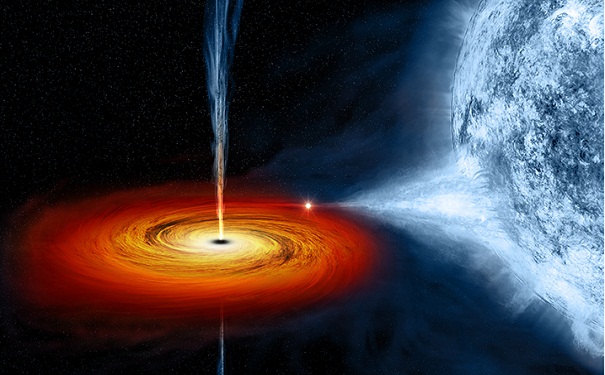
The black hole takes material from the companion star. Credit: NASA/CXC/M.Weiss
Astronomers have produced a complete description of Cygnus X-1’s black hole.
Cygnus X-1 is a binary star system, consisting of a black hole and a companion star, which was discovered to be strongly emitting x-rays nearly 50 years ago. The mass concentration of the black hole is so dense that not even light can escape from it.
Astronomers from the National Radio Astronomy Observatory in the US have managed to reconstruct the black hole’s history, dating from its birth six million years ago. The team, led by Mark Reid of the Harvard-Smithsonian Center for Astrophysics, used the National Science Foundation’s Very Long Baseline Array (VLBA) to measure the distances.
This is the first time scientists have been able to reconstruct a black hole’s complete history. In the case of Cygnus X-1, previous attempts to measure the mass and spin of the black hole lacked precise distance measurements.
“Because no other information can escape from a black hole, knowing its mass, spin, and electrical charge gives a complete description of it,” Reid said. “The charge of this black hole is nearly zero, so measuring its mass and spin make our description complete.”
The VBLA allowed the team to take precise trigonometric measurements, allowing them to calculate a distance of 6070 light years. This measurement, combined with observations from the Chandra X-Ray Observatory, the Rossi X-Ray Timing Explorer, the Advanced Satellite for Cosmology and Astrophysics, and visible-light observations, allowed scientists to determine that the black hole is spinning over 800 times per second.
The results also revealed that the black hole has a mass nearly 15 times that of our Sun, making it one of the most massive stellar black holes in the Milky Way galaxy.
“This new information gives us strong clues about how the black hole was born, what it weighed and how fast it was spinning,” Reid said. “Getting a good measurement of the distance was crucial.”
The VLBA observations, which were made during 2009 and 2010, also measured Cygnus X-1’s movement through the Milky Way. According to the scientists, the system’s movement is too slow for the black hole to have been produced by a supernova explosion.
An explosion would have given the object a kick to a much higher speed. “There are suggestions that this black hole could have been formed without a supernova explosion, and our results support those suggestions,” Reid said.
Source: National Radio Astronomy Observatory






